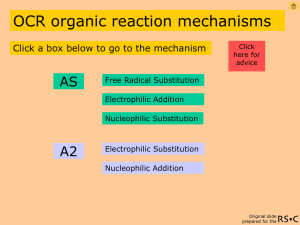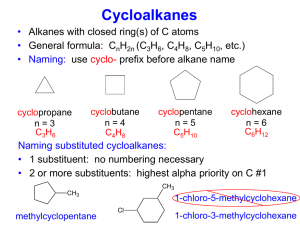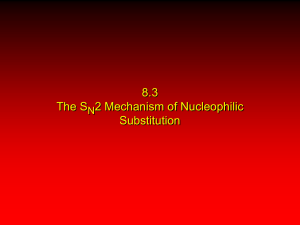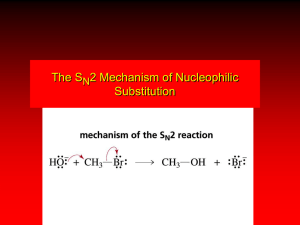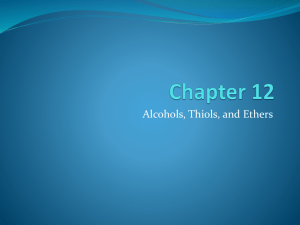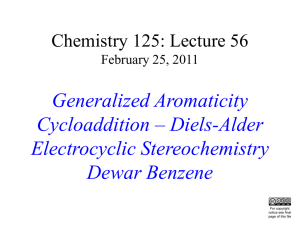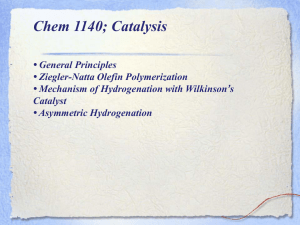- kunleoloruntegbe.com
advertisement
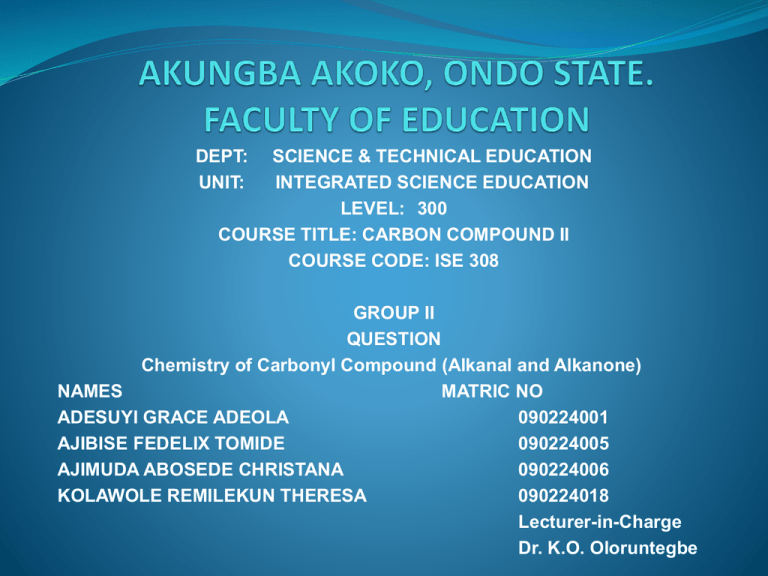
DEPT:
UNIT:
SCIENCE & TECHNICAL EDUCATION
INTEGRATED SCIENCE EDUCATION
LEVEL: 300
COURSE TITLE: CARBON COMPOUND II
COURSE CODE: ISE 308
GROUP II
QUESTION
Chemistry of Carbonyl Compound (Alkanal and Alkanone)
NAMES
MATRIC NO
ADESUYI GRACE ADEOLA
090224001
AJIBISE FEDELIX TOMIDE
090224005
AJIMUDA ABOSEDE CHRISTANA
090224006
KOLAWOLE REMILEKUN THERESA
090224018
Lecturer-in-Charge
Dr. K.O. Oloruntegbe
CARBONYL GROUP OR COMPOUNDS
ALKANALS
AND both
ALKANONES
lkanal (Aldehydes) and
Alkannone (Ketones)
contains the carbonyl group.
And this carbonyl compound is produced by which the carbon atom reacts
with a double bond of oxygen atom.
O
C
Carbonyl group
Alkanal have at least one hydrogen atom bonded to the carbon atom as well as
the oxygen.
O
R
C
H
where R= H alkyl group
Alkanal therefore has two organic radicals attached to the carbon atom which
may be the same or differ.
O
R
C
Rl
where R and Rl are the
two organic radicals.
You can tell whether a substance is an alkanal or ketone by looking at its
formula. The alkanal have a common formula RCHO while,
(2) The alkanone has its own formula as RR1CO
Aliphatic alkanals are named after the corresponding alkane by
replacing the ending “-e” with “-al”, e.g methanal (HCHO, ethanal
(CH3CHO),e.t.c.
Aromatic alkanals are named hydrocarbon carbaldehyde e.g
phenylmethanal (benzene carbaldehyde) C6H6CHO.
Aliphatic alkanones are named BY Changing the corresponding
alkane ending with “-e” to “-one” e.g propannone (CH3COCH2).
Pentane 2 –one (CH3 – CH2 – COCH3). The two common aromatic
ketones are phenylethanone C6H5COCH3 and diphenylmethanone,
(C6H5C0C6H5).
Name
Other name
Formula
State At RoomTemp.(g) BoilingPoint(0C)
Methanal Formaldehyde HCHO
254
Ethanal
Acetaldehyde CH3CHO
1
294
Propanal Propionaldehyde CH3CH2CHO
1
321
Propanone Acetone
CH3C0CH3
1
329
Butanone Methylethyl Ketone CH3C0CH2CH3 1
353
Pentan-3-one
CH3CH2COCH2CH3 1
375
Benzal-dhyde
HO
1
451
Phenyle-thanone Acetophenone
C0CH3
1
475
Solubility in water
Soluble
Infinite
Soluble
Infinite
Very soluble
Very soluble
Slight soluble
Insoluble
PHYSICAL PROPERTIES
Alkanals and Alkanones possess the following
characteristics:
1. They are often sweet smelling, volatile and liquid in nature.
2. Ethanal has a sweet characteristic which may be detected
near a rotten fruit (e.g you might try leaving an apple to rot,
eventually you will smell ethanol coming from it).
3. They are polar and are therefore soluble in water i.e the
ones with short carbon chains (1c to 5c).
4. The hydrogen bonding in alkanals and alkanone account
for their comparatively high boiling point with rest
molecular mass.
Question: Why are carbonyl
compound polar?
Answer : They are polar owning to the
electronegative oxygen drawing electron
density towards itself.
METHOD OF PREPARING ALKANAL AND ALKANONE
Oxidation of Alcohol: This is the simplest method, and it can be
achieved by using acidified solution of sodium dichromate (v) or by
passing the alcohol vapor over hot copper powder. Primary alcohols
are oxidized to alkanals and secondary alcohols to alkanone. E.g.
H
R – C - OH
H
H
(a)
+ (0)
R – C = O + H2O
from oxidizing alkanal
agent
Primary alkanal
E.g.
H
H
CH3 – C – OH + (O)
– CH3 – C = O + H2O
H
Ethanal
ethanal
R1
R1
b) R – C – OH + (O)
R - C = O + H2O
from oxidizing
alkanone
agent
Secondary alkanol
E.g
CH3
CH3
CH3 – C - OH + (O)
CH3 – C = O + H2O
H
propanone
2. Ozonolysis: This can be used to convert an alkene into alkanal or alkanones. It
swaps to carbonyl groups for the carbon-carbon double bond in an alkene.
a)
H
H
H
H
C=C
C= O+O = C
H
H
H
H
Ethene
methanal
methal
b) CH3
H
C=C
H
H
But-1-ene
(3)
CH3
H
C=C
CH3
H
CH3
H
C=O+O=C
H
propanal
H
methanal
CH3
H
C=O+O=C
CH3
Propanone
H
methal
REACTION
The alkanal and alkanones undergoes addition reaction and the following reaction are
the addition reaction.
(a) Hydrogen Sulphite Addition (HS03-): This will add to both alkanal and alkanones.
The net results of the addition is shown in this reaction.
CH3COCH3 + HSO3CH3C(OH)(SO3-)CH3
O
OH
C + HS03C
CH3 CH3
CH3
CH3 SO3
Alchohol addition: Alkanals, but not alkanones, will give addition reactions with
alcohols provided all the reagent are dry, and that Hydrochloric acid (HCL) is used
to catalyse the reaction. The most common example of this type of addition is
ethanol additing to ethanal.
dry
CH3CHO + 2C2 H5 OH HCl
CH3CH (OC2 H5)2 + H2O
1, 1 – diethoxyethane
O
twice
CH3 – C
+ 2C2 H5OH
CH3 – C – OC2 H5 + H2O
H
OC2 H5
The product, 1, 1 – diethoxyethane, was once known as Acetal. It is a type of other.
(3) Cyanide Reaction: (CN )
This particular reaction is useful because it provides us a pathway for
making mixed alcohol and acids. If a nitrile is hydrolysed, it is converted
into “carboxylic acid”. Thus, we can carry out the changes.
H+
CH3CHO
CH3 CH (OH)CN
CH3CH (OH) COOH
Ethanal 2– hydroxyl propane2-hydroxyl propanoic
Nitrile
acid
O
OH
OH
CH3 – C CN, H+ CH3
C
CH3 C
H
H
CN
COOH
2- Hydroxyl propanoic acid is also known as LACTIC ACID.
It was been widely studied because it is one of the substance made when
milk goes sour. The acid is formed by the action of a micro-organisms,
Bacillus acidi lactici, on sugar. In the early 1900’s large amount of the
bacteria were isolated and used to prepare lactic on an industry scale. The
acid was used in dyeing and also in leather industry.
It was been widely studied because it is one of the substance made
when milk goes sour. The acid is formed by the action of a microorganisms, Bacillus acidi lactici, on sugar. In the early 1900’s large
amount of the bacteria were isolated and used to prepare lactic on an
industry scale.The acid was used in dyeing and also in leather industry.
(4) REDUCTION: Alkanals are reduced to primary alkanols while alkanones
are reduced to secondary alkanols by powerful reducing agents like
lithium Tetrahydrido aluminate (III) {LiAlh4} and sodium
Tetrahydriobotrate (III) (NaBH4-).
H
CH3 – C = 0 + 2(H) CH3 CH2 - OH
Ethanal
ethanol
CH3
CH3 – C = O + H
Propanone
CH3
CH3 – C – OH
H
Propan 2- OC
(5) Oxidation: Alkanals are readily oxidized to alkanoic acids in the
presence of strong oxidizing agent like acidified potassium
tetraoxomanganate (VII) and acidified potassium heptaoxodi
chromate (v)
H
O
CH3 – C = O + (O)
CH3 C
OH
While alkanones are more different to oxidize because there is no
oxizidable hydrogen attached to the carbonyl group and it
involves breaking the C-C and C-H bonds. Only strong oxidizing
agents like hot concentrated trioxonitrate (vi) acid and acidified
KMno4 can oxidize alkanones. In the process, the Alkanones
molecule is broken up into two acids.
CH3COCH3 (O) CH3COOH + CO2 + H2O
CH3CH2CH2COCH3 (0) CH2CH2 COOH + CH3 COOH
USES
Alkanals such as:
(a)Methanal are used in solution with water, sold as formalin a disinfectant
(formaldehyde) in the preservation of same biological specimens.
(b) Methanal is also used as an imperative material in the production of
plastic such as bakelite.
(c) Ethanal is used in the manufacture of ethanoic acid and its derivatives
e.g ethanoic anhydride.
(d) More complex aldehydes are found in perfumes and flavourings.
Alkanones such as
(e) Propanone (acetone) are used as a solvent. This is a more important
used than you might think. E.g many artificial fibres are manufacture
(f) Some alkanones can be used as intermediate in the manufacture of
other chemicals, e.g cyclohexanone is used in one stage of nylon
manufacture.

